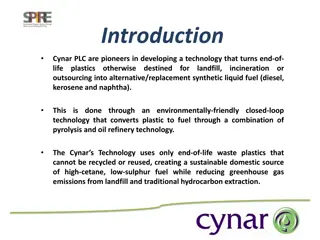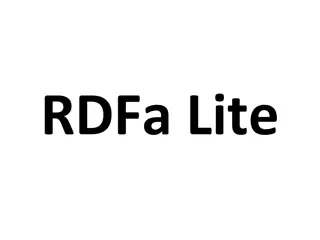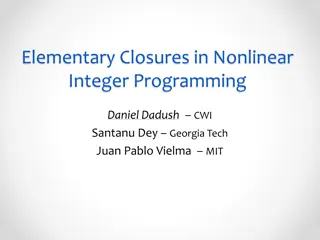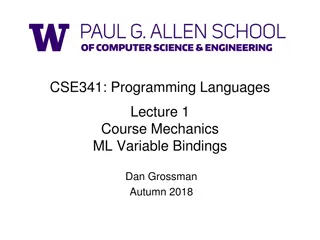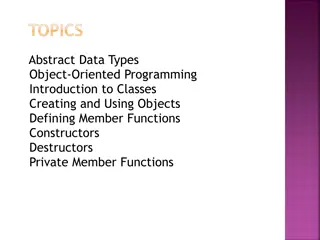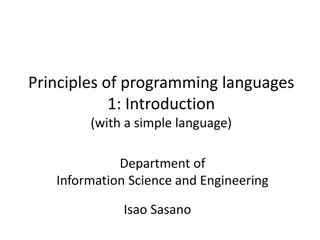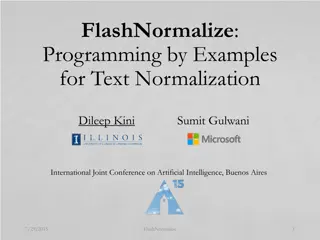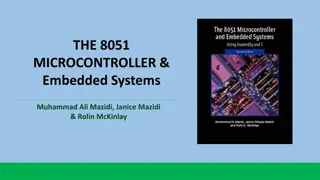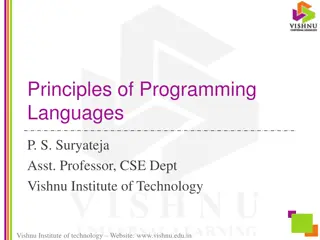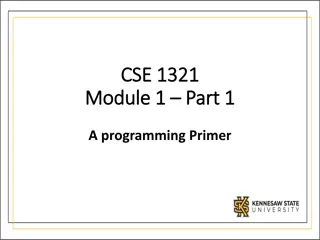Introduction to Structured Text in PLC Programming
Structured text is a high-level text language used in PLC programming to implement complex procedures not easily expressed with graphical languages. It involves logical operations, ladder diagrams, and efficient control logic for industrial automation. Concepts such as sensor input, logic operation results, normally open/closed contacts, instruction interpretations, and output coil energization are key components of structured text programming. Understanding the basics of structured text is essential for designing effective control systems in the field of industrial automation.
Download Presentation

Please find below an Image/Link to download the presentation.
The content on the website is provided AS IS for your information and personal use only. It may not be sold, licensed, or shared on other websites without obtaining consent from the author. Download presentation by click this link. If you encounter any issues during the download, it is possible that the publisher has removed the file from their server.
E N D
Presentation Transcript
Structured text is a high level text language primarily used to implement complex procedures that cannot be easily expressed with graphical languages Sensor 1 Sensor 2 SOL 1 Sensor 3 Sensor 4 Sensor 5 IF Sensor_1 AND Sensor_2 THEN SOL_1 := 1; ELSEIF Sensor_3 AND Sensor_4 AND NO T Sensor_5 THEN SOL_1 := 1; END_IF; PLC ladder and equivalent structured text program
Is closed when the bit value stored at the PII is equal to "1". When the contact is closed, ladder rail power flows across the contact and the result of logic operation (RLO) = "1 Otherwise, if the signal state at the PII is "0", the contact is open. When the contact is opened, power does not flow across the contact and the result of logic operation (RLO) = "0" Symbol Normally Open Contact Examine if closed 15 14 13 12 11 10 9 8 7 6 5 4 3 2 1 0 15 14 13 12 11 10 9 8 7 6 5 4 3 2 1 0 Bit number 1 Status 0 I1.4 I1.4 Instruction interpreted as true Instruction interpreted as false I1.4 I1.4 Examine If Closed instruction
Is closed when the bit value stored at the PII is equal to 0". When the contact is closed, ladder rail power flows across the contact and the result of logic operation (RLO) = "1 Otherwise, if the signal state at the PII is 1", the contact is open. When the contact is opened, power does not flow across the contact and the result of logic operation (RLO) = "0" Symbol Normally Open Contact Examine if opened 15 14 13 12 11 10 9 8 7 6 5 4 3 2 1 0 15 14 13 12 11 10 9 8 7 6 5 4 3 2 1 0 Bit number 1 Status 0 I1.4 I1.4 Instruction interpreted as false Instruction interpreted as true I1.4 I1.4 Examine If Opened instruction
This instruction looks and operates like a relay coil and is associated with a POI memory bit. This instruction signals the PLC to energize (switch on) or de-energize (switch off ) the output Symbol Output coil energize 14 12 15 13 10 9 8 7 6 5 11 4 1 3 2 1 0 14 12 15 13 10 9 8 7 6 5 11 4 3 2 1 0 Input data Output data 1 1 ON O2.1 I1.1 I1.1 I1.4 O2.1 Program I1.4 Input module Output module Output Coil energize instruction
The Midline Output instruction is an intermediate assigning element that stores the RLO This intermediate assigning element saves the bit logic combination of the last open branch until the assigning element is reached In a series with other contacts, the Midline Output functions as a normal contact
The Save RLO to BR Memory instruction saves the RLO to the BR bit of the status word
The Set Coil instruction is executed only if the RLO = 1 If the RLO = 1, this instruction sets its specified address to 1 If the RLO = 0, the instruction has no effect on the specified address
The Reset Coil instruction is executed only if the RLO = 1. If the RLO = 1, this instruction resets its specified address to 0 If the RLO = 0, the instruction has no effect on its specified address.
The Set Reset Flipflop instruction executes Set (S) and Reset (R) operations only when the RLO is 1 An RLO of 0 has no effect on these operations; the address specified in the operation remains unchanged A Set Reset Flipflop is set if the signal state is 1 at the S input and 0 at the R input Otherwise, if the signal state is 0 at the S input and 1 at the R input, the Flipflop is reset If the RLO is 1 at both inputs the SR flip flop executes first the Set instruction then the Reset instruction at the specified <address>, so that this address remains reset for the remainder of program scanning
The Reset Set Flipflop instruction executes Set (S) and Reset (R) operations only when the RLO is 1. An RLO of 0 has no effect on these operations; the address specified in the operation remains unchanged A Reset Set Flipflop is reset if the signal state is 1 at the R input and 0 on the S input Otherwise, if the signal state is 0 at the R input and 1 at the S input, the Flipflop is set If the RLO is 1 at both inputs, the RS flip flop executes first the Reset instruction then the Set instruction at the specified <address>, so that this address remains set for the remainder of program scanning
The operation Negative RLO Edge Detection recognizes a change in the entered address from 1 to 0 (falling edge) and displays this as RLO = 1 after the operation The current signal state in the RLO is compared with the signal state of the address, the edge memory bit If the signal state of the address is "1" and the RLO was "0" before the instruction, the RLO will be "1" (pulse) after this instruction, and "0" in all other cases.
The operation Positive RLO Edge Detection recognizes a change in the entered address from 0 to 1 (rising edge) and displays this as RLO = 1 after the operation The current signal state in the RLO is compared with the signal state of the address, the edge memory bit If the signal state of the address is "0" and the RLO was "1" before the instruction, the RLO will be "1" (pulse) after this instruction, and "0" in all other cases
NEG (Address Negative Edge Detection) compares the signal state of <address1> with the signal state from the previous scan, which is stored in <address2> If there is a change from 1 to 0, output Q is 1. Otherwise it is 0
POS (Address Positive Edge Detection) compares the signal state of <address1> with the signal state from the previous scan, which is stored in <address2> If there is a change from 0 to 1, output Q is 1. Otherwise, it is 0














